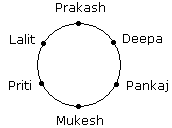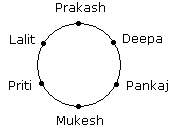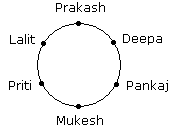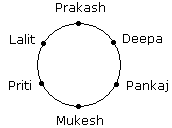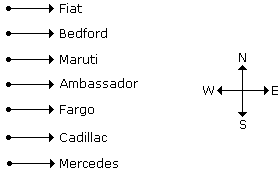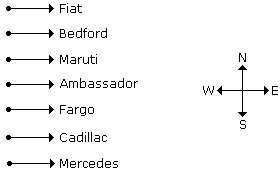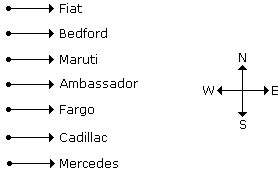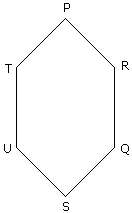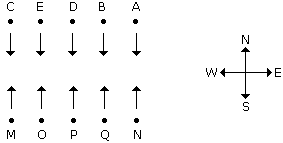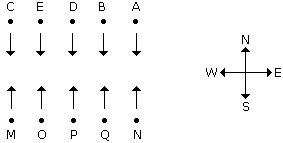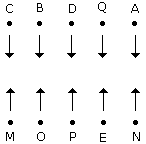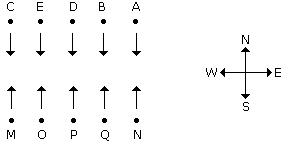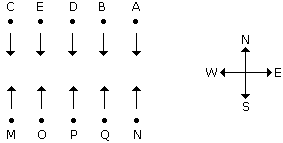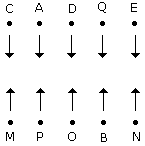Practice Test: Seating Arrangement - 4 - CAT MCQ
30 Questions MCQ Test Logical Reasoning (LR) and Data Interpretation (DI) - Practice Test: Seating Arrangement - 4
A, P, R, X, S and Z are sitting in a row. S and Z are in the centre. A and P are at the ends. R is sitting to the left of A. Who is to the right of P ?
Amit, Bharati, Cheryl, Deepak and Eric are five friends sitting in a restaurant. They are wearing caps of five different colors — yellow, blue, green, white and red. Also they are eating five different snacks — burgers, sandwiches, ice cream, pastries and pizza.
The person wearing a red cap is eating pastries.
Amit does not eat ice cream and Cheryl is eating sandwiches. Bharati is wearing a yellow cap and Amit is wearing a blue cap. Eric is eating pizza and is not wearing a green cap.
Who is Wearing the white cap ?
The person wearing a red cap is eating pastries.
Amit does not eat ice cream and Cheryl is eating sandwiches. Bharati is wearing a yellow cap and Amit is wearing a blue cap. Eric is eating pizza and is not wearing a green cap.
Who is Wearing the white cap ?
A, B, C, D and E are sitting on a bench. A is sitting next to B, C is sitting next to D, D is not sitting with E who is on the left end of the bench. C is on the second position from the right. A is to the right of B and E. A and C are sitting together. In which position A is sitting ?
A supermarket has to place 12 items (coded A to L) in shelves numbered 1 to 16. Five of these items are types of biscuits, three are types of candies and the rest are types of savouries. Only one item can be kept in a shelf. Items are to be placed such that all items of same type are clustered together with no empty shelf between items of the same type and at least one empty shelf between two different types of items. At most two empty shelves can have consecutive numbers.
The following additional facts are known.
- A and B are to be placed in consecutively numbered shelves in increasing order.
- I and J are to be placed in consecutively numbered shelves both higher numbered than the shelves in which A and B are kept.
- D, E and F are savouries and are to be placed in consecutively numbered shelves in increasing order after all the biscuits and candies.
- K is to be placed in shelf number 16.
- L and J are items of the same type, while H is an item of a different type.
- C is a candy and is to be placed in a shelf preceded by two empty shelves.
- L is to be placed in a shelf preceded by exactly one empty shelf.
In how many different ways can the items be arranged on the shelves?
A supermarket has to place 12 items (coded A to L) in shelves numbered 1 to 16. Five of these items are types of biscuits, three are types of candies and the rest are types of savouries. Only one item can be kept in a shelf. Items are to be placed such that all items of same type are clustered together with no empty shelf between items of the same type and at least one empty shelf between two different types of items. At most two empty shelves can have consecutive numbers.
The following additional facts are known.
- A and B are to be placed in consecutively numbered shelves in increasing order.
- I and J are to be placed in consecutively numbered shelves both higher numbered than the shelves in which A and B are kept.
- D, E and F are savouries and are to be placed in consecutively numbered shelves in increasing order after all the biscuits and candies.
- K is to be placed in shelf number 16.
- L and J are items of the same type, while H is an item of a different type.
- C is a candy and is to be placed in a shelf preceded by two empty shelves.
- L is to be placed in a shelf preceded by exactly one empty shelf.
Which of the following items is not a type of biscuit?
A supermarket has to place 12 items (coded A to L) in shelves numbered 1 to 16. Five of these items are types of biscuits, three are types of candies and the rest are types of savouries. Only one item can be kept in a shelf. Items are to be placed such that all items of same type are clustered together with no empty shelf between items of the same type and at least one empty shelf between two different types of items. At most two empty shelves can have consecutive numbers.
The following additional facts are known.
- A and B are to be placed in consecutively numbered shelves in increasing order.
- I and J are to be placed in consecutively numbered shelves both higher numbered than the shelves in which A and B are kept.
- D, E and F are savouries and are to be placed in consecutively numbered shelves in increasing order after all the biscuits and candies.
- K is to be placed in shelf number 16.
- L and J are items of the same type, while H is an item of a different type.
- C is a candy and is to be placed in a shelf preceded by two empty shelves.
- L is to be placed in a shelf preceded by exactly one empty shelf.
Which of the following can represent the numbers of the empty shelves in a possible arrangement?
A supermarket has to place 12 items (coded A to L) in shelves numbered 1 to 16. Five of these items are types of biscuits, three are types of candies and the rest are types of savouries. Only one item can be kept in a shelf. Items are to be placed such that all items of same type are clustered together with no empty shelf between items of the same type and at least one empty shelf between two different types of items. At most two empty shelves can have consecutive numbers.
The following additional facts are known.
- A and B are to be placed in consecutively numbered shelves in increasing order.
- I and J are to be placed in consecutively numbered shelves both higher numbered than the shelves in which A and B are kept.
- D, E and F are savouries and are to be placed in consecutively numbered shelves in increasing order after all the biscuits and candies.
- K is to be placed in shelf number 16.
- L and J are items of the same type, while H is an item of a different type.
- C is a candy and is to be placed in a shelf preceded by two empty shelves.
- L is to be placed in a shelf preceded by exactly one empty shelf.
Which of the following statements is necessarily true?
Directions to Solve
Five girls are sitting on a bench to be photographed. Seema is to the left of Rani and to the right of Bindu. Mary is to the right of Rani. Reeta is between Rani and Mary.
Question - Who is sitting immediate right to Reeta?
Directions to Solve
Five girls are sitting on a bench to be photographed. Seema is to the left of Rani and to the right of Bindu. Mary is to the right of Rani. Reeta is between Rani and Mary.
Question - Who is in the middle of the photograph?
Directions to Solve
Five girls are sitting on a bench to be photographed. Seema is to the left of Rani and to the right of Bindu. Mary is to the right of Rani. Reeta is between Rani and Mary.
Question - Who is second from the right?
Directions to Solve
Five girls are sitting on a bench to be photographed. Seema is to the left of Rani and to the right of Bindu. Mary is to the right of Rani. Reeta is between Rani and Mary.
Question - Who is second from the left in photograph?
Directions to Solve
Six friends are sitting in a circle and are facing the centre of the circle. Deepa is between Prakash and Pankaj. Priti is between Mukesh and Lalit. Prakash and Mukesh are opposite to each other.
Question - Who is sitting right to Prakash?
Directions to Solve
Six friends are sitting in a circle and are facing the centre of the circle. Deepa is between Prakash and Pankaj. Priti is between Mukesh and Lalit. Prakash and Mukesh are opposite to each other.
Question - Who is just right to Pankaj?
Directions to Solve
Six friends are sitting in a circle and are facing the centre of the circle. Deepa is between Prakash and Pankaj. Priti is between Mukesh and Lalit. Prakash and Mukesh are opposite to each other.
Question - Who are the neighbours of Mukesh?
Directions to Solve
Six friends are sitting in a circle and are facing the centre of the circle. Deepa is between Prakash and Pankaj. Priti is between Mukesh and Lalit. Prakash and Mukesh are opposite to each other.
Question - Who is sitting opposite to Priti?
Directions to Solve
In an Exhibition seven cars of different companies - Cadillac, Ambassador, Fiat, Maruti, Mercedes, Bedford and Fargo are standing facing to east in the following order :
- Cadillac is next to right of Fargo.
- Fargo is fourth to the right of Fiat.
- Maruti car is between Ambassador and Bedford.
- Fiat which is third to the left of Ambassador, is at one end.
Question - Which of the cars are on both the sides of cadillac car?
Directions to Solve
In an Exhibition seven cars of different companies - Cadillac, Ambassador, Fiat, Maruti, Mercedes, Bedford and Fargo are standing facing to east in the following order :
- Cadillac is next to right of Fargo.
- Fargo is fourth to the right of Fiat.
- Maruti car is between Ambassador and Bedford.
- Fiat which is third to the left of Ambassador, is at one end.
Question - Which of the following statement is correct?
Directions to Solve
In an Exhibition seven cars of different companies - Cadillac, Ambassador, Fiat, Maruti, Mercedes, Bedford and Fargo are standing facing to east in the following order :
- Cadillac is next to right of Fargo.
- Fargo is fourth to the right of Fiat.
- Maruti car is between Ambassador and Bedford.
- Fiat which is third to the left of Ambassador, is at one end.
Question - Which one of the following is the correct position of Mercedes?
Directions to Solve
In an Exhibition seven cars of different companies - Cadillac, Ambassador, Fiat, Maruti, Mercedes, Bedford and Fargo are standing facing to east in the following order :
- Cadillac is next to right of Fargo.
- Fargo is fourth to the right of Fiat.
- Maruti car is between Ambassador and Bedford.
- Fiat which is third to the left of Ambassador, is at one end.
Question - Which one of the following statements is correct?
Directions to Solve
In an Exhibition seven cars of different companies - Cadillac, Ambassador, Fiat, Maruti, Mercedes, Bedford and Fargo are standing facing to east in the following order :
- Cadillac is next to right of Fargo.
- Fargo is fourth to the right of Fiat.
- Maruti car is between Ambassador and Bedford.
- Fiat which is third to the left of Ambassador, is at one end.
Question - Which of the following groups of cars is to the right of Ambassador?
Directions to Solve
Six friends P, Q, R, S, T and U are sitting around the hexagonal table each at one corner and are facing the centre of the hexagonal. P is second to the left of U. Q is neighbour of R and S. T is second to the left of S.
Question - Which one is sitting opposite to P?
Directions to Solve
Six friends P, Q, R, S, T and U are sitting around the hexagonal table each at one corner and are facing the centre of the hexagonal. P is second to the left of U. Q is neighbour of R and S. T is second to the left of S.
Question - Who is the fourth person to the left of Q?
Directions to Solve
Six friends P, Q, R, S, T and U are sitting around the hexagonal table each at one corner and are facing the centre of the hexagonal. P is second to the left of U. Q is neighbour of R and S. T is second to the left of S.
Question - Which of the following are the neighbours of P?
Directions to Solve
Six friends P, Q, R, S, T and U are sitting around the hexagonal table each at one corner and are facing the centre of the hexagonal. P is second to the left of U. Q is neighbour of R and S. T is second to the left of S.
Question - Which one is sitting opposite to T?
Directions to Solve
Each of these questions are based on the information given below:
- A ,B, C, D and E are five men sitting in a line facing to south - while M, N, O, P and Q are five ladies sitting in a second line parallel to the first line and are facing to North.
- B who is just next to the left of D, is opposite to Q.
- C and N are diagonally opposite to each other.
- E is opposite to O who is just next right of M.
- P who is just to the left of Q, is opposite to D.
- M is at one end of the line.
Question - Who is sitting third to the right of O?
Directions to Solve
Each of these questions are based on the information given below:
- A ,B, C, D and E are five men sitting in a line facing to south - while M, N, O, P and Q are five ladies sitting in a second line parallel to the first line and are facing to North.
- B who is just next to the left of D, is opposite to Q.
- C and N are diagonally opposite to each other.
- E is opposite to O who is just next right of M.
- P who is just to the left of Q, is opposite to D.
- M is at one end of the line.
Question - If B shifts to the place of E, E shifts to the place of Q, and Q shifts to the place of B, then who will be the second to the left of the person opposite to O?
Directions to Solve
Each of these questions are based on the information given below:
- A ,B, C, D and E are five men sitting in a line facing to south - while M, N, O, P and Q are five ladies sitting in a second line parallel to the first line and are facing to North.
- B who is just next to the left of D, is opposite to Q.
- C and N are diagonally opposite to each other.
- E is opposite to O who is just next right of M.
- P who is just to the left of Q, is opposite to D.
- M is at one end of the line.
Question - Which of the following pair is diagonally opposite to each other?
Directions to Solve
Each of these questions are based on the information given below:
- A ,B, C, D and E are five men sitting in a line facing to south - while M, N, O, P and Q are five ladies sitting in a second line parallel to the first line and are facing to North.
- B who is just next to the left of D, is opposite to Q.
- C and N are diagonally opposite to each other.
- E is opposite to O who is just next right of M.
- P who is just to the left of Q, is opposite to D.
- M is at one end of the line.
Question - In the original arrangement who is sitting just opposite to N?
Directions to Solve
Each of these questions are based on the information given below:
- A ,B, C, D and E are five men sitting in a line facing to south - while M, N, O, P and Q are five ladies sitting in a second line parallel to the first line and are facing to North.
- B who is just next to the left of D, is opposite to Q.
- C and N are diagonally opposite to each other.
- E is opposite to O who is just next right of M.
- P who is just to the left of Q, is opposite to D.
- M is at one end of the line.
Question - If O and P, A and E and B and Q interchange their positions, then who will be the second person to the right of the person who is opposite to the person second of the right of P?
Directions to Solve
A, B, C, D, E, F and G are sitting in a row facing North :
- F is to the immediate right of E.
- E is 4th to the right of G.
- C is the neighbour of B and D.
- Person who is third to the left of D is at one of ends.
Question - Who are to the left of C?
|
92 videos|123 docs|94 tests
|
|
92 videos|123 docs|94 tests
|














